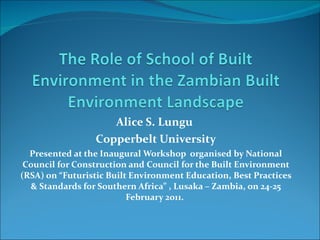Cbu Sbe Presentation
- 1. Alice S. Lungu Copperbelt University Presented at the Inaugural Workshop organised by National Council for Construction and Council for the Built Environment (RSA) on âFuturistic Built Environment Education, Best Practices & Standards for Southern Africaâ , Lusaka â Zambia, on 24-25 February 2011.
- 2. CONTENTS Brief history - CBU SBE Contribution to the Zambian Built Environment Landscape Way forward
- 3. BRIEF HISTORY OF CBU Originally known as UNZANDO, was located at former Zambia Institute of Technology (ZIT) premises in Kitwe. Annexed to University of Zambia (UNZA) and became one of three UNZA campuses: University of Zambia at Lusaka University of Zambia at Ndola (UNZANDO) University of Zambia at Solwezi (Proposed)
- 4. BRIEF HISTORY (CONTD). In 1987 UNZANDO and ZIT amalgamated and became known as the Copperbelt University (CBU). Started with two schools: School of Business School of Built Environment (formerly School of Environmental Studies) Later on other schools were introduced.
- 5. SCHOOL OF BUILT ENVIRONMENT Initially called School of Environmental Studies (SES). Established in 1975 but operationalised in 1981 when the first students were admitted. Later on name changed to School of Built Environment (SBE). SBE produced its first graduates in 1986 locally, regionally and globally. SBE is made up of four interrelated departments
- 6. DEPARTMENTS Architecture Building Science Real Estate Urban and Regional Planning
- 7. DEPARTMENT OF ARCHITECTURE Undergraduate degree: Bachelor of Architecture The first year of study is common to all students in the school. In second year of study Architectural and Building Science students learn together. Specialisation into Architecture begins in third year through fourth year.
- 8. ARCHITECTURE (CONTD) In fifth year, students are exposed to professional practice: They have courses common to other fifth years students in other departments They also have individual projects to work on. Plans are underway to introduce a postgraduate degree in the field of housing.
- 9. DEPARTMENT OF BUILDING SCIENCE Two undergraduate degrees: Bachelor of Science in Quantity Surveying and Bachelor of Science in Construction Management Postgraduate degree â Master of Science in Project Management First and second years undergraduate study is similar to Architecture. In the third year of study, students begin to exposed to fields of quantity surveying and construction management.
- 10. BUILDING SCIENCE (CONTD) In fourth year of study students branch into either quantity surveying or construction management. In fifth year, students are exposed to professional practice: They have common courses with other fifth years students in other departments They also have individual projects to work on.
- 11. CONTRIBUTION TO THE ZBE LANDSCAPE Major contributions have been through: Training Degree programmes Short courses Research Building materials Consultancy CBU Communities
- 12. STRATEGIES ADOPTED Linkage with industry Participation in professional bodies Industrial attachments Education tours â national and international Open days Seminars, conferences, workshops Use of software
- 13. WAY FORWARD Work with other stakeholders in the Zambian Built Environment (ZBE): Research and development Standards development and improvement Curriculum development for future programmes
- 14. THE END THANK YOU ALL!













